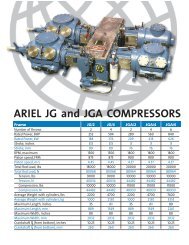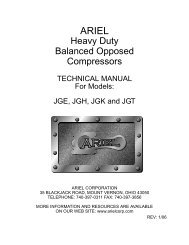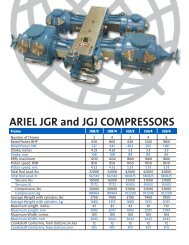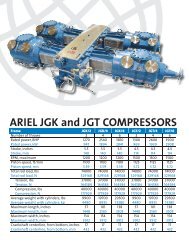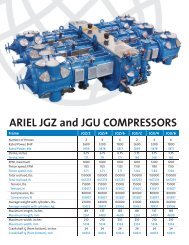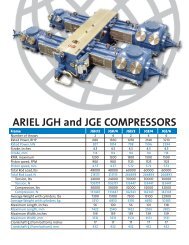Heavy Duty Balanced Opposed Compressors
Heavy Duty Balanced Opposed Compressors
Heavy Duty Balanced Opposed Compressors
You also want an ePaper? Increase the reach of your titles
YUMPU automatically turns print PDFs into web optimized ePapers that Google loves.
FOR MODELS: JG AND JGA SECTION 5 - MAINTENANCE<br />
Using a non-metallic sleeve from the crosshead side will help ensure that packing<br />
rings are not damaged. An optional piston rod entering sleeve, Part Number<br />
A-8561, is available from Ariel (refer to Figure 7-3: on page 7-3).<br />
2. Screw the crosshead nut onto the piston rod. Make sure all threads and nut<br />
seating surfaces are well lubricated with clean, fresh oil to ensure proper assembly.<br />
Position the crankshaft in the inner dead center position. Remove a crank<br />
end discharge valve. Determine the required piston crank end clearance as<br />
shown on the cylinder identification plate. Refer to Table 1-2 on page 1-8. Insert<br />
a feeler gage, equal to the required crank end clearance, thru the discharge<br />
valve pocket. A special feeler gauge is provided with 2-3/4M, 3M, 2-3/4P-CE<br />
and 3-1/4P-CE class cylinders only (refer to Figure 7-2: on page 7-3). Use the<br />
Piston Nut Spanner and a speed wrench to screw the piston rod into the crosshead<br />
until piston is snug against the feeler gage. (For the 2-1/4P-CE class cylinder,<br />
it is not possible to use a crank end feeler gauge. For this class, with<br />
crankshaft in the inner dead center position, screw piston rod assembly hand<br />
tight against the crank end head, then turn out, loosen, 1/2 turn.) Snug the<br />
crosshead nut, but do not tighten. Remove the feeler gage.<br />
3. Ensure that the Piston Turning Tool has been removed. Replace the cylinder<br />
head and gasket. Tighten all cylinder head bolts evenly to the proper torque<br />
value listed in Table 1-15 on page 1-15.<br />
4. Remove a head end suction valve. Determine the required piston head end<br />
clearance as shown on the cylinder identification plate. Refer to Table 1-2 on<br />
page 1-8. Rotate the crankshaft 180° to the outer dead center position, and<br />
using the feeler gages thru the valve pocket, check the head end clearance.<br />
Determine that measured clearance is within the required clearance limits.<br />
5. Tighten the crosshead nut to the proper torque value listed in Table 1-15 on<br />
page 1-15.<br />
6. Tighten set screws in the crosshead nut.<br />
7. Before installing the side covers, apply an anti-seize lubricant to the gaskets.<br />
This will aid removal at a later date.<br />
8. Replace the crosshead guide side covers; tighten all capscrews.<br />
9. Replace the valve assemblies, tighten all valve cap bolts evenly to the proper<br />
torque value listed in Table 1-15 on page 1-15.<br />
Piston Rod Run Out<br />
Check piston rod run out after installing a new unit, after relocating a unit or after any maintenance<br />
that could affect rod run out.<br />
Verify that the crosshead guides are properly shimmed to level. Refer to See “Procedure For<br />
Setting and Aligning” on Page 2-1. Verify that the crossheads are in direct contact with the<br />
bottom guide. A 0.0015 inches (0.04 mm) feeler stock should not be able to be inserted<br />
more than 1/2 inches (13 mm) at all four corners of the crosshead.<br />
Position the dial indicator 1 stem against the piston rod, close to the packing case. Set the<br />
indicator to zero with the piston toward the crank end. Readings are to be taken in both the<br />
1. Use a 0.0001 inches (0.001 mm) increment dial indicator.<br />
11/01 PAGE 5 - 21





